An integrated farm management system should lead to an automation of business procedures and process chains in combined milk and energy production in agricultural businesses. This system should also facilitate networking in regional energy networks.
The so-called Demand Side Management, in which operational energy consumption is adapted to the amount of energy currently produced, provides the basis for such a system. To that end, it is necessary to precisely forecast energy production for a future period of time to enable the planning of production processes based on this.
Furthermore, the energy use of various consumers is recorded in detail and their priority in the production system is evaluated.
Building on this information, a decision algorithm optimises energy use according to economical and production priorities.
In addition to the time flexibility of various production processes e.g. feeding and mucking out, battery storage devices as well as energy storage systems in dairy farming, such as compressed air or ice water storage, are used to make energy consumption more flexible.
The foundations for this are currently being developed and tested in practical operation. By aligning the system towards the individual animal and taking the animal-technology interaction into account, the system contributes towards promoting animal welfare.
Resources can be conserved by improving electronic control, regulation, automation, and surveillance of the entire process chain. While, in addition to automated data acquisition and management, the interaction between technology and management and employees is playing an important role, too.


